Samoyeds are one of the most popular dog breeds worldwide, known for their snowy white, fluffy coats, ever-gleaming smiles, and friendly disposition.
It is a medium-to-large-sized dog in height and weight, and it is really friendly and gentle. To be a truly devoted Samoyed owner, one should know how a Samoyed grows from those adorable little puppies into fully grown gorgeous dogs.
The provided detailed growth chart will enable you to monitor your Samoyed dog’s growth trajectory and development until it reaches its adult size.
This article takes you through the main key stages of Samoyed’s healthy growth, giving detailed charts for Samoyed’s weights & heights and insights into what to expect at each phase.
Whether you are a novice or fully professional in matters regarding Samoyeds, these growth milestones will have you learning how to cope with feeding, exercise, and general health.
You can also reference them to check if your pup’s current weight or height is within the breed standard.
Now, look at the interesting journey of growing a happy and healthy adult dog.
Growth Differences In Male and Female Samoyeds
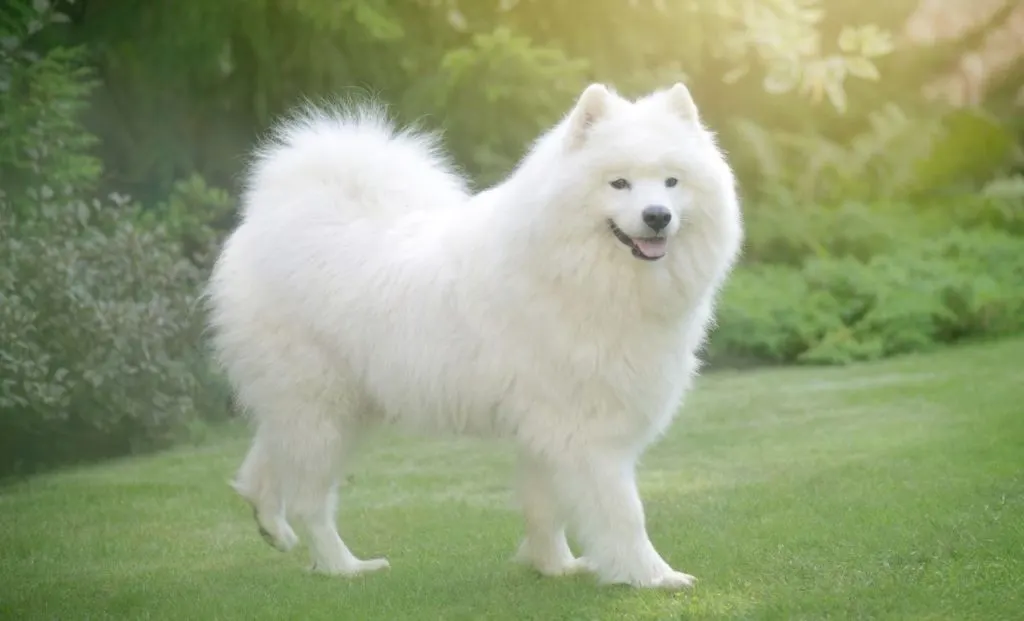
If you are a proud parent of a Samoyed dog, you know these dogs are hardy and intelligent with sweet characters.
Samoyed puppies’ growing and transition period is full of differences between the male and female Samoyeds.
Male Samoyed Samoyed Weights & Heights
The following chart includes the standard weights and heights of a male Samoyed from newborn to 2 years of age.
All the information was sourced from the American Kennel Club (AKC) Samoyed breed standard.
Please remember that these are only averages. Always consult your vet if you worry about the development of the particular dog in front of you.
| Age (months) | Weight (kg) | Height (cm) | Weight (Ibs) | Height (inch) |
|---|---|---|---|---|
| Newborn | 0.5 | 10.0 | 1.1 | 3.94 |
| 1 | 1.4 | 15.0 | 3.09 | 5.91 |
| 2 | 3.2 | 20.0 | 7.05 | 7.87 |
| 3 | 5.0 | 25.0 | 11.02 | 9.84 |
| 4 | 6.8 | 30.0 | 14.99 | 11.81 |
| 5 | 8.6 | 35.0 | 18.96 | 13.78 |
| 6 | 10.4 | 40.0 | 22.93 | 15.75 |
| 7 | 12.2 | 45.0 | 26.9 | 17.72 |
| 8 | 14.0 | 50.0 | 30.86 | 19.69 |
| 9 | 15.8 | 55.0 | 34.83 | 21.65 |
| 10 | 17.6 | 60.0 | 38.8 | 23.62 |
| 11 | 19.4 | 61.0 | 42.77 | 24.02 |
| 12 | 21.2 | 62.0 | 46.74 | 24.41 |
| 18 | 32.0 | 68.0 | 70.55 | 26.77 |
| 24 | 42.8 | 70.0 | 94.36 | 27.56 |
This table is based on the breed standard and can differ significantly depending on individual dogs.
Please always talk to your vet or the breeder for more specific and personal information about your puppy.
Female Samoyed Weights & Heights
The following chart includes the standard weights and heights of a female Samoyed from newborn to 2 years of age.
All the information was sourced from the American Kennel Club (AKC) Samoyed breed standard.
Please remember that these are only averages. Always consult your vet if you worry about the development of the particular dog in front of you.
| Age (months) | Weight (kg) | Height (cm) | Weight (Ibs) | Height (inch) |
|---|---|---|---|---|
| Newborn | 0.4 | 9.0 | 0.88 | 3.54 |
| 1 | 1.2 | 14.0 | 2.65 | 5.51 |
| 2 | 2.8 | 19.0 | 6.17 | 7.48 |
| 3 | 4.4 | 24.0 | 9.7 | 9.45 |
| 4 | 6.0 | 29.0 | 13.23 | 11.42 |
| 5 | 7.6 | 34.0 | 16.76 | 13.38 |
| 6 | 9.2 | 39.0 | 20.28 | 15.35 |
| 7 | 10.8 | 44.0 | 23.81 | 17.32 |
| 8 | 12.4 | 49.0 | 27.34 | 19.29 |
| 9 | 14.0 | 54.0 | 30.86 | 21.26 |
| 10 | 15.6 | 59.0 | 34.39 | 23.23 |
| 11 | 17.2 | 60.0 | 37.92 | 23.62 |
| 12 | 18.8 | 61.0 | 41.45 | 24.02 |
| 18 | 28.4 | 67.0 | 62.61 | 26.38 |
| 24 | 38.0 | 69.0 | 83.50 | 27.17 |
This table is based on the breed standard and can differ significantly depending on individual dogs.
Please always talk to your vet or the breeder for more specific and personal information about your puppy.
Growth Patterns
Males of the breed are typically large Samoyeds and are weightier than the females. Adult males usually weigh between 45 and 65 pounds, standing about 21 to 23.5 inches at the withers.
Mostly, they undergo spurts of growth during the first year of life. These spurts and rapid development contribute to the overall large frame and amount of muscle.
The growth of the Samoyeds is more pronounced in the first months, which is why they require a diet rich in protein and nutrients for growth.
The largest females, on the other hand, weigh 35-50 pounds and reach 19-21 inches in height. They share the peak growth period, but within the female sex it occurs more evenly and at a less intense pace.
Females achieve full size a little sooner than males and are often done with most upward growth by 12 to 18 months.
Physical Development
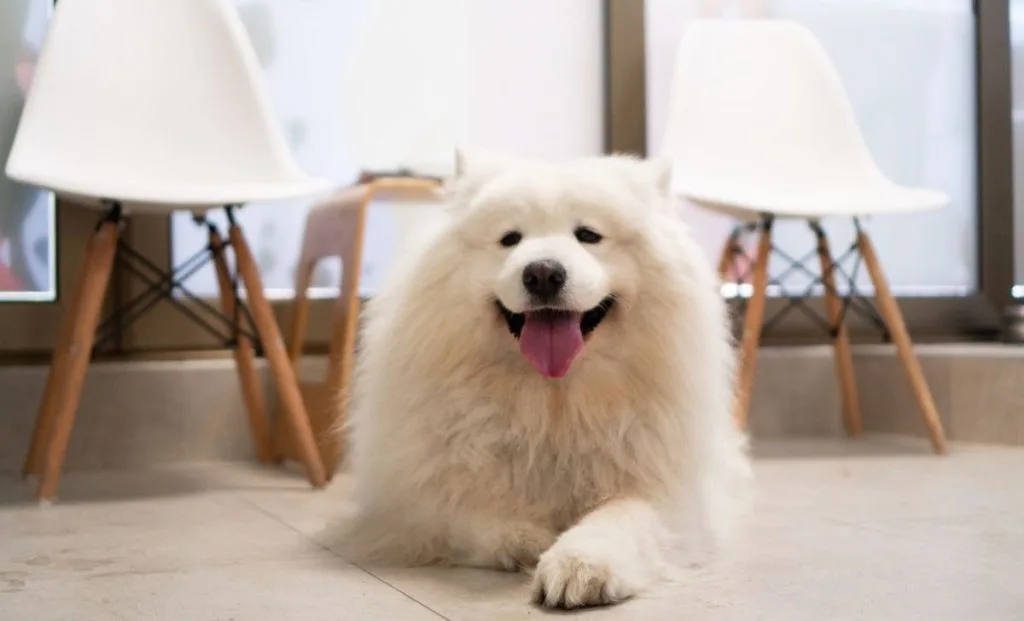
The male Samoyeds tend to be more muscular and stalwart in terms of physical development. That is all shown in the dogs’ larger size and muscle mass when they have reached maturity, thus making them look more imposing.
All this will often translate into males having a higher energy level and requiring more energetic exercise to avoid health problems like obesity.
In the female Samoyed, the body similarly appears robust and muscular, but the development style is more streamlined, giving them a graceful look.
They are slightly smaller since they require more agility and greater endurance. The females probably can do with less severe exercise than the males but definitely need to be on the go regularly to keep their figure and overall health.
Maturity Rates
Maturity rates vary between male and female Samoyeds as well. Males generally lag in both physical and mental maturity.
They may continue to grow and fill out until 2 or 3 years of age. This delayed growth period will require its owner to exercise patience and be consistent because mental growth may lag behind physical maturity.
Males generally take somewhat more time to mature and develop compared to females, who mostly mature at around the age of 2 years.
This early maturity of female Samoyeds makes training them and controlling their behavior much easier.
More often than not, they are well-behaved when they reach adulthood, but of course, this can vary with the individual.
The Journey from Puppyhood to Adulthood
Neonatal Stage (0-2 Weeks)

After successful whelping in the whelping box, the puppy is born dependent on the mother.
The tiny furballs are born blind, deaf, and toothless and remain so for the first two weeks. The principal activities at this stage are nursing, sleeping, and very gentle crawling.
Their mother keeps them warm and nourished since the pups have not yet developed body temperature regulation.
Human presence at very early stages is kept low to avoid troubling the mother or the puppies.
Transitional Stage (2-4 Weeks)
At around two weeks, changes in Samoyed puppies start to become quite noticeable.
Their eyes open at 10-14 days, and they start being able to see the world in which they live. Their ears will open, and they begin reacting to sounds.
Social interactions with littermates and the pups’ development of minor play activity increase. This starts the beginning of limited mobility, as puppies can be seen trying to get up and move around.
The mother’s role in instructing and instilling early social skills becomes more evident as the pups’ activity levels rise to explore their world.
Socialization Phase (4-12 Weeks)
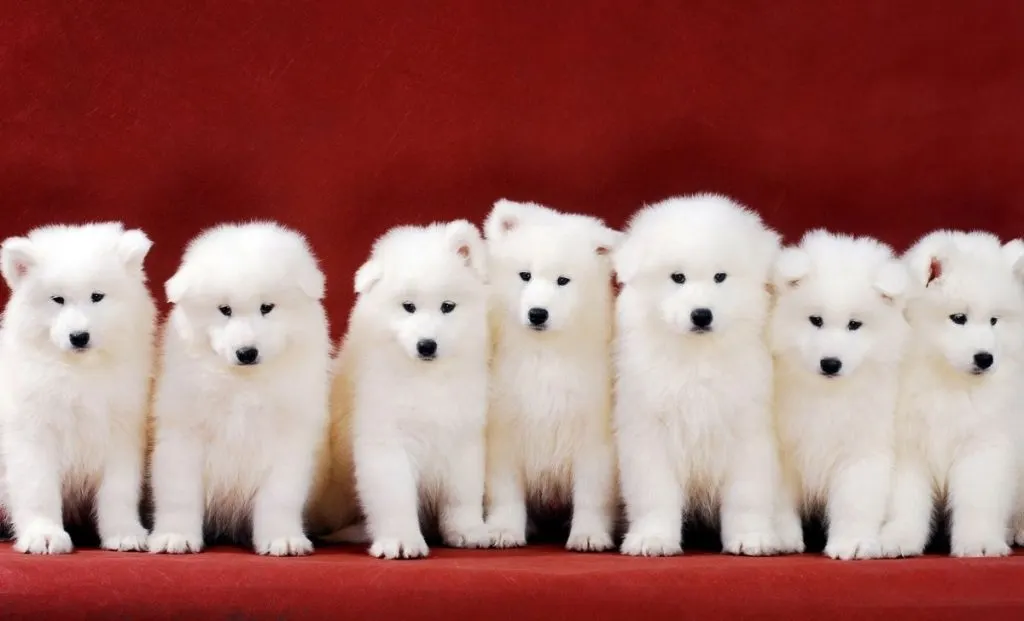
This is the most important time for a Samoyed puppy.
During these weeks, the puppies become much more active and curious; they are much more interested in and involved with the world around them and the humans in that world.
They begin to be weaned off Mama’s milk and onto food. This is the best time for the first vet visits and shots.
General training and positive early experiences of different stimuli, such as people, other animals, different environments, and sounds, are crucial for dogs to develop in a healthy manner.
Basic commands and concepts for training are placed at this stage, such as housebreaking and introduction to a leash.
This is the best way to lay down the groundwork for lifelong good behavior.
Juvenile Stage (3-6 Months)
As the Samoyed puppies approach the juvenile period, they become more independent and energetic.
They start becoming more mischievous, and they really do need to exercise continuously to try and use up all that energy.
Puppies continue to grow fast and gain weight; at about this time, they will lose most of their baby teeth, and their adult teeth will start to come through.
It is a very important period in their training and socialization processes to avoid the development of unwanted habits and to enforce good behavior.
At this stage, puppies will test the boundaries, so patience and positive reinforcement are required.
Adolescence (6-18 Months)

Puberty for Samoyed puppies looks much the same as their human teenage counterparts; they can be downright stubborn and seem to want to assert their independence from your commands.
Physical development will slow, but mental and emotional growth will be ongoing.
Training must remain consistent and at a challenging level to keep the puppies interested and well-behaved.
Socialization is important to keep them from fearing or being aggressive toward new situations.
Include plenty of exercise and activity for Samoyeds, who can become quite destructive when bored.
Young Adulthood (18-24 Months)
By two years, samoyed puppies are now fully grown in size and weight and are considered young adults.
They are more settled in their behavior yet playful and energetic indoors. Basic commands are carried far beyond these commands into complex tasks and even specialized activities, possibly including agility or therapeutic work.
Their health and well-being depend on the regularity of their exercise and proper nutrition.
They will make up the social and emotional bond with their human family members, making them loyal and affectionate companions.
Adulthood (2-6 Years)
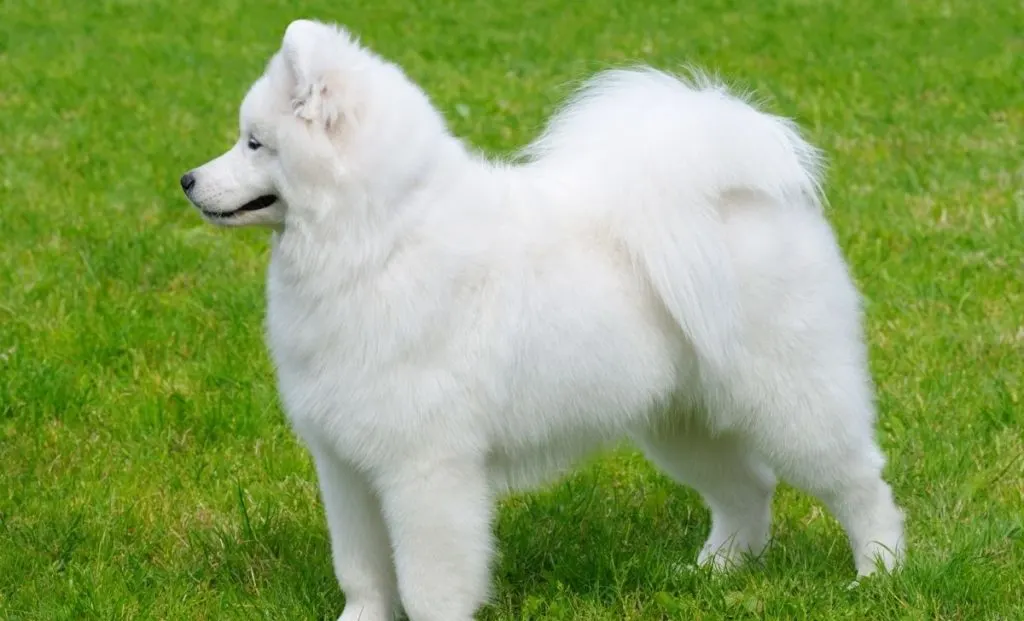
At this point in their life, the Samoyeds are at the peak of their physical and mental acuity.
At this point, normal exercise and mental challenges befit a dog. By nature, it is gentle, and the mature Samoyed is a very friendly dog and will easily fit into the family.
Obedience training and socialization ensure continuing good manners and adaptability.
They thrive on companionship and have a great time being part of family activities, from hiking to simply lounging around the house.
Senior Years (6+ Years)
In the same way as other dogs, the Samoyed may start being slow in its later years but still remain very loving and loyal.
Regular vet checks are important and may need to be upped in the later years to make sure health issues are caught early.
Diet and exercise will need modifying to fit their requirements. Many Samoyeds are still very playful into their senior years and love interacting with their family.
A comfortable environment with low stress goes a long way toward an enjoyable and healthy life in the twilight years.
Factors That Influence Samoyed Growth

Let’s go over the primary contributions of Samoyed’s growth and how they actully contribute to overall development.
- Genetics: The genetic makeup of the puppy goes a long way in determining most of the potential size of a Samoyed puppy, coat quality, temperament, and susceptibility to certain hereditary diseases. Breeders, which emphasize the goal of health and breed standards, successfully produce puppies with sturdy genetic backgrounds.
- Nutrition: The second most cardinal element, after all, is that a great, perfectly balanced diet is a great place to start. In this regard, a Samoyed puppy can obtain nutritional support for growth and development from a balanced diet and the right dog food. Age-specific food should be fed to the puppy: high-quality proteins, fats, vitamins, and minerals. Overfeeding is counterproductive and could result in the growth of abnormalities and obesity, which often bring about long-term health issues.
- Exercise/Physical activity: Regular exercise is very important for developing a normal Samoyed puppy and goes a long way to developing a Samoyed puppy. Moderate regular exercise helps to develop strong muscles and bones, prevent obesity, and ensure good physical health. Physical health, however, remains safe if too much exercise or high-impact physical activity is avoided at the puppy growth stage, mainly due to bones and joints still being soft and underdeveloped and the fact they can’t endure much pressure.
- Health care: consistent visits to the veterinary clinic, vaccination, deworming, and parasite preventives. Early diagnosis and treatment of possible diseases are the guarantee to prevent growth retardation, maintain the puppy healthy, control the growth process, and allow timely interference in the case of any abnormality. Proper physical and mental development depends on exposure to a safe, clean, and stimulating environment. The puppies will become more confident and well-adapted to the environment if reared in a relatively enriched environment.
- Socialization and training are two highly important aspects that go a long way in the psychological development of a Samoyed pup. Early socialization with humans, other dogs, and various environments will make a puppy well-rounded and confident. Training the puppy through positive reinforcement during its formative years aims to build trust and a strong bond between the owner and the puppy, bringing about good behavior and great mental well-being.
- Breeding practices are the very first indicators of what kind of life will be afforded to a puppy, and responsible breeders will ensure the mother and her babies are well cared for and nurtured from the time of pregnancy up to weaning. They would also ensure that there are health checks to minimize the risks of hereditary diseases.
How Much Should My Puppy Eat And What Kind Of Diet Should It Have
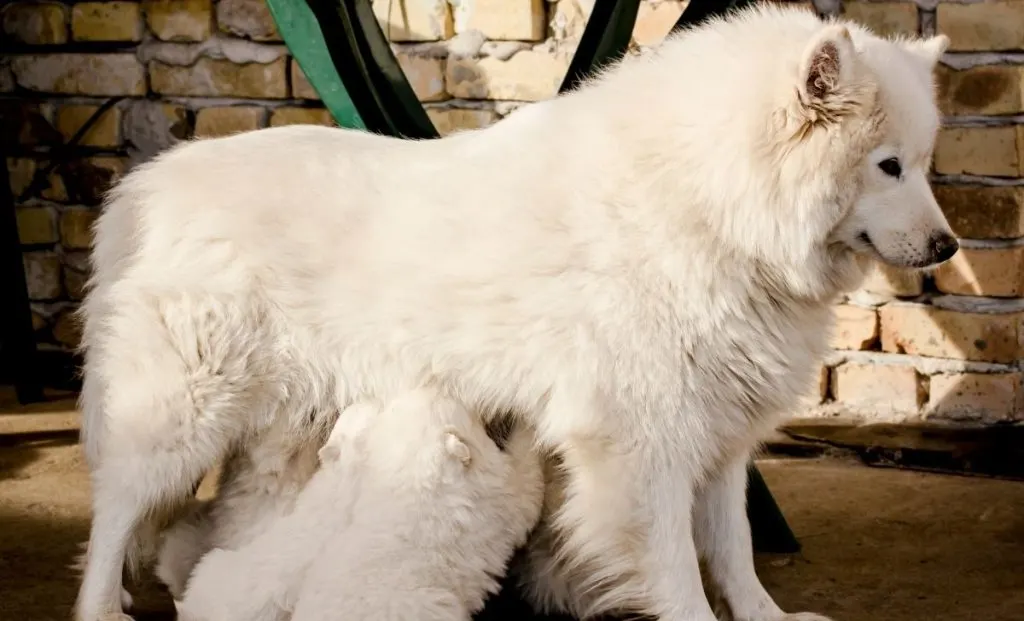
A proper, complete, balanced Samoyed puppy diet is vital for their healthful growth.
A Samoyed puppy should be put on good-quality puppy food, at about 1 to 1.5 cups per day.
This should be divided into three equal meals up to approximately six months of age. Generally, by the time they are adults, the amount would increase to 2.5 to 3 cups daily, fed in two meals a day.
The best kind of diet is large-breed puppy dog food that best supports their story so that they will receive all the nutrients needed.
These foods support controlled growth and provide the right calcium-phosphorus balance to develop healthy bone structures.
Protein diets complement muscle growth, while fat complements the coat and gives energy. Omega fatty acids are particularly good for their fur.
The food should also contain DHA to support brain and eye development. Do not overfeed, and be careful not to allow a young puppy to grow fat too quickly, as this can stress its developing body and cause joint issues and other health problems.
Always provide fresh water and adjust the quantity and type of food offered according to your puppy’s growth, activity level, and specific health problems.
Feel free to ask your veterinarian for advice in this area.
Possible Growth Issues With Samoyed Puppies
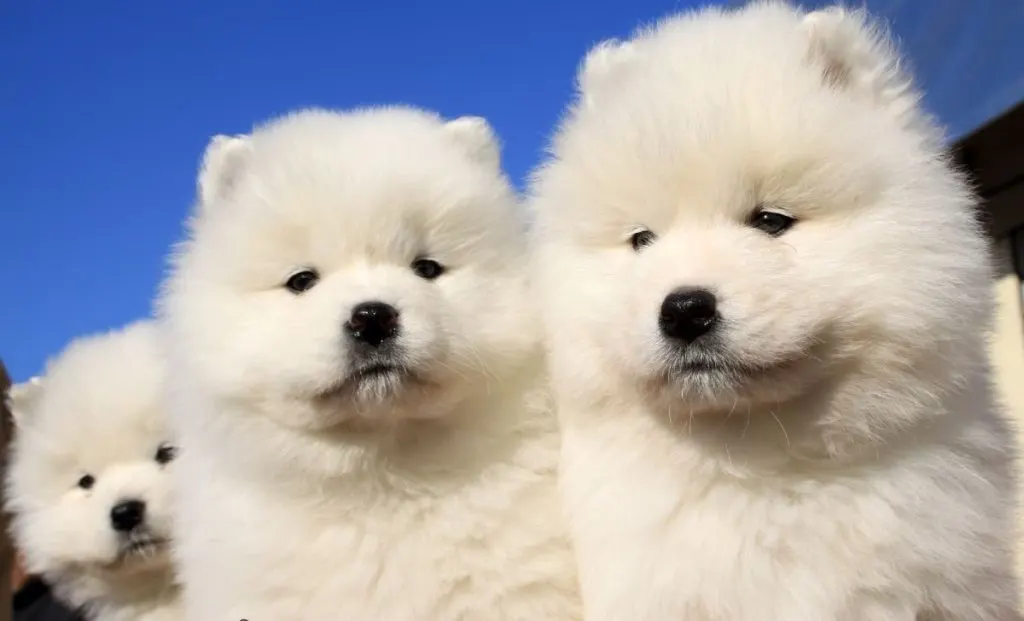
Samoyed puppies typically are fluffy, gentle, and quiet, but they can have several issues with growth, usually associated with growth speed and their large breed characteristics.
One of the common disorders is hip dysplasia, which is genetic and occurs at that time when the hip joint has not been properly fitted into the socket.
The result is pain and arthritis. Just like hip dysplasia, elbow dysplasia is likely to occur, which is a harmful and painful affection of the elbow joints.
Such puppies may also develop osteochondritis dissecans, a condition whereby the cartilage of the joints grows incorrectly and statistically, leading to stiffness and lameness.
Their denseness in the coating of the body also makes the Samoyed more prone to another condition or zinc-responsive dermatosis, a condition whereby they cannot absorb the amount of zinc required and thus develop skin problems.
How Do Genetics Influence Samoyed Growth
Genetics comes first among the variables that influence the growth and development of a Samoyed puppy.
Hereditary factors are among the foremost determinants of a Samoyed’s maximum size, weight, and general body structure.
A puppy’s growth is directly related to the size of the parents since many of the genes that control size are directly inherited.
Genetics also impact the growth rate in Samoyed puppies. How quickly they grow and develop is also hereditary from their parents, so how fast they mature depends on their growth patterns.
This will affect their nutritional needs in the way that they will best be managed for their diet for their effective growth.
Genetics also play a role in the health of a Samoyed puppy, determining biological vulnerability to certain problems that can disturb the growth process, such as hip dysplasia or other hereditary problems.
That change affects the overall growth rate and can make it necessary for an intervention to proceed so that the course of puppy development will be altered.
To Sum It All Up
As your Samoyed grows, witnessing each stage of their development towards full height and adult weight is a delightful journey filled with many white fluffy coats and warm companionship.
Your Friday evening in front of the TV or an early Friday morning walk will never be spent alone again. These magnificent dogs bring beauty and joy to your home and become an integral part of your family.
If you have a thing for larger puppies, don’t forget the male Samoyed weighs more than the female. As clear as it is, let me mention that if you like smaller puppies, females are the way to go for you.
Patience and consistent training are key as your Samoyed puppy matures into a dignified and lovable adult.
We wish you a wonderful adventure with your pup, full of love, laughter, and unforgettable memories.
Good luck, and may your days be as bright and cheerful as your Samoyed’s smile!

Nandina has been a lifelong dog owner and enthusiast. She shared her home with multiple breeds, including Giant Schnauzers, Cane Corsos, and Huskies. Currently, she is raising a three-year-old rescue and a working-line German Shepherd puppy.
Actively engaged in IGP dog sports for two years, Nandina is a certified instructor for basic obedience and socialization. She works as a trainer in her local dog sports club, and in her spare time, she handicrafts biothane gear for dogs.
